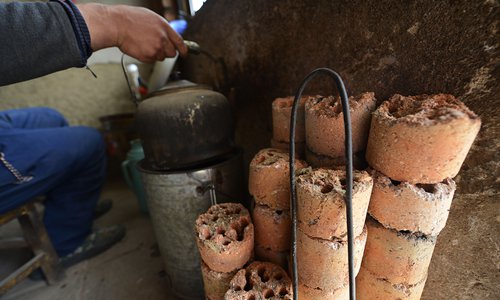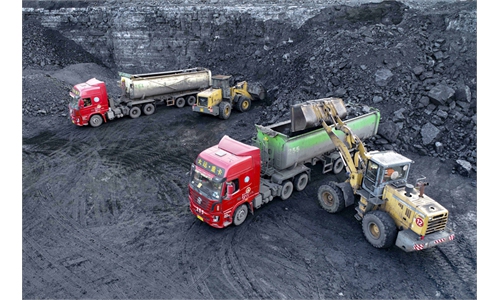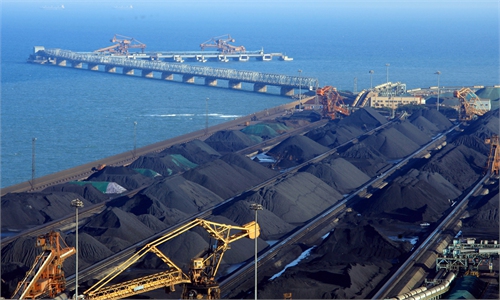
A resident heats water on a coal-burning stove. File Photo: VCG
A recent trip to by the Global Times to East China's Shandong Province to get a glimpse of China's coal supply chain revealed a surprising discovery: there are large numbers of rural households in northern China that still rely on burning coal to pass the winter. Of course, it is understandable given that China is a vastly diverse country with many regions in different development stages. For those rural households that have not shifted to cleaner natural gas or are connected to the central heating system, burning coal is the norm.
"(Smokeless) anthracite is the best fuel for the winter, it fires up our self-made heating system," one local resident told the Global Times.
Yet, amid an acute shortage of thermal coal for heat generation and a cold front arriving earlier than usual, many farmers have been confronted with the hard reality that coal prices have risen by nearly 300 percent from last year. At some rural coal trading markets the price for the fuel rose from 1,100 yuan ($172) per ton last year to 2,800 yuan ($438) . At some other markets, traders simply said they could not secure supplies.
Constantly improving living standards in China has meant enduring the discomfort of an entire winter with determination and many households have to accept the situation as it is and pay an outrageous price.
Coal prices have been soaring but only in recent months. For much of 2021, the price of coal futures has not exceeded 900 yuan ($140) per ton. As late as October 1, the future price was at about 1,400 yuan ($218) per ton. Prices then began to soar, climbing to a historic high in less than one month.
There are multiple factors pushing coal prices to climb higher and higher including a restrained supply, difficulties in transportation, an earlier winter, a sudden massive rise in demand from power companies to cope with rising electricity demand, and speculation by capital market investors looking for windfall fortune. All these factors are at work at once at the coal supply chain where private capital enjoy active participation.
To put brakes on soaring coal prices, the government has taken measures, from a probe to crack down on speculation, to calls on mines to increase output, to the arrangement of coal transportation, to push down coal prices.
But marketization means there will always be speculators. Winter is not a black swan. With more and more participants in the market for bulk commodities, it appears to be a high time for farmers, who have a rigid demand for coal as winter fuel, to also participate in it. This will allow them to secure what is needed ahead of time at more affordable prices and not rush into the market at the last minute. Here, some sense on the fluctuating of the commodity market could forestall the plight of expensive coal in winter. Just like for speculators, the market's door is also open to farmers.

A resident heats water on a coal-burning stove. File Photo: VCG
A recent trip to by the Global Times to East China's Shandong Province to get a glimpse of China's coal supply chain revealed a surprising discovery: there are large numbers of rural households in northern China that still rely on burning coal to pass the winter. Of course, it is understandable given that China is a vastly diverse country with many regions in different development stages. For those rural households that have not shifted to cleaner natural gas or are connected to the central heating system, burning coal is the norm.
"(Smokeless) anthracite is the best fuel for the winter, it fires up our self-made heating system," one local resident told the Global Times.
Yet, amid an acute shortage of thermal coal for heat generation and a cold front arriving earlier than usual, many farmers have been confronted with the hard reality that coal prices have risen by nearly 300 percent from last year. At some rural coal trading markets the price for the fuel rose from 1,100 yuan ($172) per ton last year to 2,800 yuan ($438) . At some other markets, traders simply said they could not secure supplies.
Constantly improving living standards in China has meant enduring the discomfort of an entire winter with determination and many households have to accept the situation as it is and pay an outrageous price.
Coal prices have been soaring but only in recent months. For much of 2021, the price of coal futures has not exceeded 900 yuan ($140) per ton. As late as October 1, the future price was at about 1,400 yuan ($218) per ton. Prices then began to soar, climbing to a historic high in less than one month.
There are multiple factors pushing coal prices to climb higher and higher including a restrained supply, difficulties in transportation, an earlier winter, a sudden massive rise in demand from power companies to cope with rising electricity demand, and speculation by capital market investors looking for windfall fortune. All these factors are at work at once at the coal supply chain where private capital enjoy active participation.
To put brakes on soaring coal prices, the government has taken measures, from a probe to crack down on speculation, to calls on mines to increase output, to the arrangement of coal transportation, to push down coal prices.
But marketization means there will always be speculators. Winter is not a black swan. With more and more participants in the market for bulk commodities, it appears to be a high time for farmers, who have a rigid demand for coal as winter fuel, to also participate in it. This will allow them to secure what is needed ahead of time at more affordable prices and not rush into the market at the last minute. Here, some sense on the fluctuating of the commodity market could forestall the plight of expensive coal in winter. Just like for speculators, the market's door is also open to farmers.



